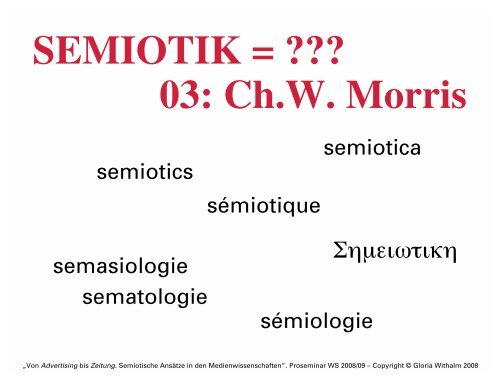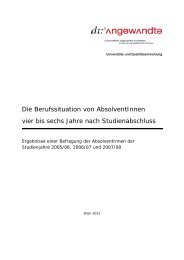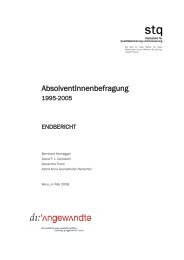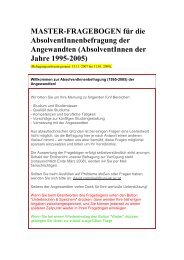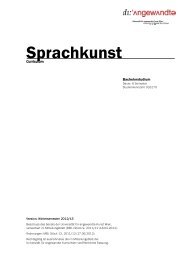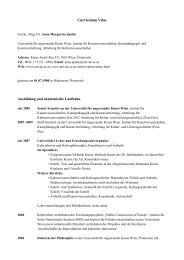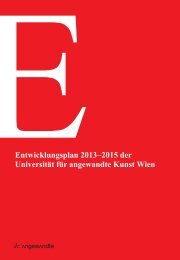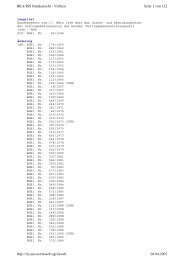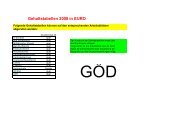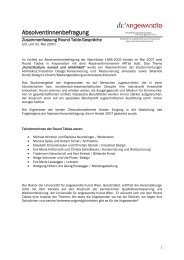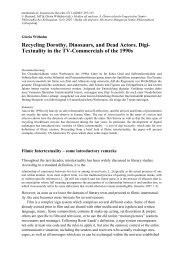SEMIOTIK = ??? 03: Ch.W. Morris
SEMIOTIK = ??? 03: Ch.W. Morris
SEMIOTIK = ??? 03: Ch.W. Morris
You also want an ePaper? Increase the reach of your titles
YUMPU automatically turns print PDFs into web optimized ePapers that Google loves.
<strong>SEMIOTIK</strong> = ???<br />
<strong>03</strong>: <strong>Ch</strong>.W. <strong>Morris</strong><br />
semiotics<br />
semiotica<br />
sémiotique<br />
semasiologie<br />
sematologie<br />
sémiologie<br />
μ<br />
„Von Advertising bis Zeitung. Semiotische Ansätze in den Medienwissenschaften“. Proseminar WS 2008/09 – Copyright © Gloria Withalm 2008
<strong>Ch</strong>arles W. <strong>Morris</strong><br />
(1901-1979)<br />
[Copyright © Gloria Withalm 2007/2008]
<strong>Ch</strong>arles W. <strong>Morris</strong> —Publikationen<br />
(1938). Foundations of the Theory of Signs. = International Encyclopedia of<br />
Unified Sciences 1(2). <strong>Ch</strong>icago: University of <strong>Ch</strong>icago Press [Dt.: Grundlagen<br />
der Zeichentheorie. Ästhetik und Zeichentheorie. München: Hanser<br />
1972]<br />
(1946). Signs, Language, and Behavior. New York: Braziller [Dt.: Zeichen,<br />
Sprache und Verhalten. Düsseldorf: Schwann 1973]<br />
(1964). Signification and Significance: A Study of the Relations of Signs and<br />
Values. Cambridge, MA: MIT Press<br />
(1971). Writings on the General Theory of Signs. The Hague & Paris: Mouton<br />
(1975). Zeichen Wert Ästhetik. Mit einer Einl. hg. u. übers. Achim Eschbach.<br />
Frankfurt<br />
(1993). Symbolism and Reality. A Study in the Nature of Mind. With a<br />
preface by Achim Eschbach (= Foundations of Semiotics. 15).<br />
Amsterdam–Philadelphia: John Benjamins 1993 [re-edited Ph.D. thesis<br />
(University of <strong>Ch</strong>icago 1925)]<br />
[Copyright © Gloria Withalm 2007/2008]
<strong>Ch</strong>arles W. <strong>Morris</strong> über Semiotik<br />
“It is doubtful if signs have ever before been so vigorously<br />
studied by so many persons and from so many points<br />
of view. The army of investigators includes linguists,<br />
logicians, philosophers, psychologists, biologists, anthropologists,<br />
psychopathologists, aestheticians, and sociologists.”<br />
(<strong>Morris</strong> 1938: 1)<br />
[Copyright © Gloria Withalm 2007/2008]
<strong>Ch</strong>arles W. <strong>Morris</strong> über Semiotik<br />
“Semiotic* has for its goal a general theory of signs in all<br />
their forms and manifestations, whether in animals or<br />
men, whether normal or pathological, whether linguistic<br />
or nonlinguistic, whether personal or social. Semiotic is<br />
thus an interdisciplinary enterprise.<br />
Part of the widespread interest in this area is motivated<br />
by the belief that higher-level sign processes (often called<br />
symbols) are of central importance in understanding man<br />
and his works.”<br />
* <strong>Morris</strong> hat den Begriff semiotic für die Disziplin verwendet und nicht die heute gebräuchliche Plural-for-<br />
Singular Konstruktion semiotics (etwa analog zu linguistics).<br />
[<strong>Morris</strong>, <strong>Ch</strong>arles W. (1964). “Signs and the Act”. In: ders.: Signification and Significance. Cambridge MA: The MIT<br />
Press; reprinted in: Innis, Robert E. (ed). (1985). Semiotics: An Introductory Anthology. Bloomington: Indiana<br />
University Press, hier: p. 178]<br />
[Copyright © Gloria Withalm 2007/2008]
<strong>Ch</strong>arles W. <strong>Morris</strong>: Semiotik<br />
„Die Zeichentheorie als die Wissenschaft von den Zeichenprozessen<br />
(Semiosen) ist von den Zeichenprozessen ebenso<br />
verschieden wie jede andere Wissenschaft von ihrem Gegenstandsbereich<br />
verschieden ist.<br />
[…]<br />
Die Semiotik als Wissenschaft benutzt spezielle Zeichen, um<br />
Aussagen über Zeichen zu machen; sie ist eine Sprache, in<br />
der man über Zeichen spricht. Die Semiotik zerfällt in die Teildisziplinen<br />
Syntaktik, Semantik und Pragmatik, die jeweils die<br />
syntaktische, die semantische und die pragmatische Dimension<br />
der Semiose behandeln.“<br />
(nach <strong>Morris</strong> 1938/1972: 25-26)<br />
[Copyright © Gloria Withalm 2007/2008]
<strong>Ch</strong>arles W. <strong>Morris</strong><br />
“From the cradle to the grave, from awakening until sleep,<br />
the contemporary individual is subjected to an unending<br />
barrage of signs through which other persons seek to advance<br />
their goals. He is told what to believe, what to approve<br />
and disapprove, what to do and not to do. If he is not alert,<br />
he becomes a veritable robot manipulated by signs, passive<br />
in his beliefs, his valuations, his activities. […]<br />
Against this exploitation of individual life, semiotic can<br />
serve as a counter force. When an individual meets the signs<br />
with which he is confronted with a knowledge of how signs<br />
work, he is better able to co-operate with others when cooperation<br />
is justified.”<br />
(<strong>Morris</strong> 1946: 240)<br />
[Copyright © Gloria Withalm 2007/2008]
<strong>Ch</strong>arles W. <strong>Morris</strong>, Otto Neurath<br />
& Rudolf Carnap: Unified Science<br />
mehrere Kongresse, letzter = 5. Kongress 1939<br />
Journal of Unified Science<br />
International Encyclopedia of Unified Science (Hg.: Carnap, <strong>Morris</strong>,<br />
Neurath)<br />
Band 1.2:<br />
<strong>Morris</strong>, <strong>Ch</strong>arles W. (1938). Foundations of the Theory of Signs.<br />
[zeitgenössische Buchbesprechung des ersten Bandes: Time Magazine, August 1, 1938;<br />
Web: ]<br />
[Copyright © Gloria Withalm 2007/2008]
<strong>Ch</strong>arles W. <strong>Morris</strong>: 3 Strömungen<br />
die nordamerikanische Tradition des (kritischen)<br />
Pragmatismus (<strong>Ch</strong>.S. Peirce, William James, George<br />
Herbert Mead, John Dewey, C.I. Lewis)<br />
die anglo-amerikanische Tradition des Empirismus<br />
(Empiristen 17./18. Jh., Behaviorismus),<br />
die mitteleuropäische Tradition des Logischen Positivismus<br />
(Ernst Mach, Moritz Schlick, Ludwig Wittgenstein,<br />
Rudolf Carnap, Hans Reichenbach, F Waismann),<br />
(cf. Posner, Roland (1981). „<strong>Ch</strong>arles <strong>Morris</strong> und die verhaltenstheoretischen Grundlagen der Semiotik“. In:<br />
Krampen, Martin, Klaus Oehler, Roland Posner & Thure von Uexküll (Hg.) (1981). Die Welt als Zeichen. Klassiker<br />
der modernen Semiotik. Berlin: Severin und Siedler, 54)<br />
[Copyright © Gloria Withalm 2007/2008]
<strong>Ch</strong>icago Philosophy Club, 1896<br />
“Standing: Cora Allen, Mr. Henderson, Miss Clark, Louis G. Whitehead, George Herbert Mead, John Dewey,<br />
Amy Tanner, unknown, Addison W. Moore, J. D. Forrest<br />
Seated: unknown, Edward Scribner Ames, Mrs. Forrest, Simon F. MacLennan, unknown, unknown, unknown”<br />
(Web online: ,<br />
; retrieved: 2007-10-31)<br />
[Copyright © Gloria Withalm 2007/2008]
<strong>Ch</strong>arles W. <strong>Morris</strong>: Drei Dimensionen 1<br />
“It is important, <strong>Morris</strong> insisted, to embrace an empiricism<br />
which is radical, a rationalism which is a study of method, and<br />
a pragmatism which is critical. These are the three components<br />
that correspond to the three dimensions of semiotics. Radical<br />
empiricism is semantic investigation, methodological rationalism<br />
is syntactic investigation, critical pragmatism is pragmatic<br />
investigation. The unity of science thus results from the unity<br />
of its linguistic structure, from the semantic relationships which<br />
it succeeds in establishing, and from the practical effects it<br />
produces. Notice that in this way even the three traditional<br />
fields of philosophy – logic, metaphysics, and the theory of<br />
values – were indirectly re-presented in semiotic terms.”<br />
(Rossi-Landi, Ferruccio (1978). “On some Post-<strong>Morris</strong>ian problems”. In: Rossi-Landi, Ferruccio. Between Signs and<br />
Non-signs. Ed. by Susan Petrilli. Amsterdam: John Benjamins 1992, 63 [orig.publ. in: Ars semeiotica 3/1978: 3-31])<br />
[Copyright © Gloria Withalm 2007/2008]
<strong>Ch</strong>arles W. <strong>Morris</strong>: Drei Dimensionen 2<br />
“The term ‘pragmatics’ has obviously been coined with<br />
reference to the term ‘pragmatism.’ It is a plausible view that<br />
the permanent significance of pragmatism lies in the fact that it<br />
has directed attention more closely to the relation of signs to<br />
their users than had preciously been done and has assessed<br />
more profoundly than ever before the relevance of this rela-tion<br />
in understanding intellectual activities. The term ‘pragmatics’<br />
helps to signalize the significance of the achievements of Peirce,<br />
James, Dewey, and Mead within the field of semiotic. At the<br />
same time, ‘pragmatics’ as a specifically semiotic term must<br />
receive its own formulation. By ‘pragmatics’ is designated the<br />
science of the relation of signs to their interpreters. ‘Pragmatics’<br />
must then be distinguished from ‘pragmatism,’ and<br />
‘pragmatical’ from ‘pragmatic.’”<br />
[<strong>Morris</strong> 1938, zit.n.1971: 43]<br />
[Copyright © Gloria Withalm 2007/2008]
<strong>Ch</strong>arles W. <strong>Morris</strong>: Drei Dimensionen 3<br />
“Pragmatics is that portion of semiotic which deals with the<br />
origin, uses and effects of signs within the behavior in which<br />
they occur; semantics deals with the signification of signs in all<br />
modes of signifying; syntactics deals with combinations of<br />
signs without regard for their specific significations or their<br />
relation to the behavior in which they occur.”<br />
[<strong>Morris</strong> 1946: 219]<br />
[Copyright © Gloria Withalm 2007/2008]
Zeichen: der Zeichenträger<br />
– steht nie allein, sondern in<br />
Beziehung zu anderen Zeichenträgern<br />
[= syntaktische Dimension];<br />
– steht für etwas anderes<br />
[= semantische Dimension];<br />
– werden produziert, rezipiert,<br />
interpretiert<br />
[= pragmatische Dimension]<br />
[Copyright © Gloria Withalm 2007/2008]
Zeichen: der Zeichenträger<br />
– steht nie allein, sondern in<br />
Beziehung zu anderen Zeichenträgern<br />
[= syntaktische Dimension];<br />
– steht für etwas anderes<br />
[= semantische Dimension];<br />
– werden produziert, rezipiert,<br />
interpretiert<br />
[= pragmatische Dimension]<br />
[Copyright © Gloria Withalm 2007/2008]
Zeichen: der Zeichenträger<br />
– steht nie allein, sondern in<br />
Beziehung zu anderen Zeichenträgern<br />
[= syntaktische Dimension];<br />
– steht für etwas anderes<br />
[= semantische Dimension];<br />
– wird produziert, rezipiert,<br />
interpretiert<br />
[= pragmatische Dimension]<br />
StVO<br />
[Copyright © Gloria Withalm 2007/2008]
<strong>Ch</strong>arles W. <strong>Morris</strong>: semiosis<br />
“A dog responds by the type of behavior (I) involved in the<br />
hunting of chipmunks (D) to a certain sound (S); a traveler<br />
prepares himself to deal appropriately (I) with the geographical<br />
region (D) in virtue of the letter (S) received from a<br />
friend. In such cases S is the sign vehicle (and a sign in virtue<br />
of its functioning), D the designatum, and I the interpretant of<br />
the interpreter. The most effective characterization of a sign<br />
is the following: S is a sign of D for I to the degree that I takes<br />
account of D in virtue of the presence of S. Thus in semiosis<br />
something takes account of something else mediately, i.e.,<br />
by means of a third something. Semiosis is accordingly a<br />
mediated-taking-account-of. The mediators are sign vehicles;<br />
the takings-account-of are interpretants; the agents of the<br />
process are interpreters; what is taken account of are<br />
designata.”<br />
(nach <strong>Morris</strong> 1938: 20-21; 1972: 20-21)<br />
[Copyright © Gloria Withalm 2007/2008]
<strong>Ch</strong>arles W. <strong>Morris</strong>: Semiose<br />
(nach <strong>Morris</strong> 1972: 94)<br />
[Copyright © Gloria Withalm 2007/2008]
<strong>Ch</strong>arles W. <strong>Morris</strong>: Semiosis 0<br />
“For present purposes the basic terms of semiotic can be introduced<br />
as follows: Semiosis (or sign process) is regarded as a<br />
five-term relation — v, w, x, y, z — in which v sets up in w the<br />
disposition to react in a certain kind of way, x, to a certain kind<br />
of object, y (not then acting as a stimulus), under certain conditions,<br />
z. The v’s, in the cases where this relation obtains, are<br />
signs, the w’s are interpreters, the x’s are interpretants, the y’s<br />
are significations, and the z’s are the contexts in which the signs<br />
occur.”<br />
[<strong>Morris</strong>, <strong>Ch</strong>arles W. (1964). “Signs and the Act”. In: ders.: Signification and Significance. Cambridge, MA: The<br />
MIT Press; reprinted in: Innis, Robert E. (ed). (1985). Semiotics: An Introductory Anthology. Bloomington: Indiana<br />
University Press, hier: p. 178]<br />
[Copyright © Gloria Withalm 2007/2008]
<strong>Ch</strong>arles W. <strong>Morris</strong>: designatum vs. denotatum<br />
“This distinction was originally proposed by <strong>Morris</strong> in Foundations (1938). He addressed<br />
the same question again, with terminological variants, in Sign, Language and Behavior<br />
(1946), and yet again in later writings. Even so, his position as established in 1938 remains<br />
the most convincing.<br />
As he states in Foundations: “Where what is referred to actually exists as referred to<br />
the object of reference is a denotatum’ (1938, in 1971: 20). For example, if the sign ‘unicorn’<br />
refers to the object and if we consider unicorns as existent in the world of mythology, that<br />
siogn has a denotatum because it exists in that world. In contrast, if the sign ‘unicorn’ refers<br />
to its object of reference and if we consider unicorns as existent in the world of zoology,<br />
that sign does not have a denotatum, because it does not exist in that world. Here, the sign<br />
has a designatum (<strong>Morris</strong> 1938) – or a significatum, as <strong>Morris</strong> (1946) was later to call it […] –<br />
but it does not have a denotatum: ‘It thus becomes clear that, while every sign has a<br />
designatum, not every sign has a denotatum’ (ibid.). […]<br />
As we might expect, this distinction is maintained in Sign, Language and Behavior with<br />
the introduction of a terminological variation: the term designatum is replaced with the<br />
term significatum. <strong>Morris</strong> states: ‘Those conditions which are such that whatever fulfills<br />
them is a denotatum will be called a significatum of the sign’ (1971 [1946]: 94).”<br />
“In other words, the designatum or significatum is that which the sign or sign-vehicle<br />
refers to; it is a set of qualities forming a class or type of objects or events, to which the<br />
interpreter reacts independently of whether what is referred to actually exists (denotatum)<br />
according to the existence value attributed to it by the sign. In Signification and Significance,<br />
<strong>Morris</strong> replaces the term ‘significatum’ with ‘signification’ and drops altogether the<br />
term ‘denotatum’.”<br />
(Petrilli. Susan & Augusto Ponzio (2005). Semiotics Unbounded. Interpretive Routes through the Open Network of<br />
Signs. Toronto: University of Toronto Press, 193-194, 195)<br />
[Copyright © Gloria Withalm 2007/2008]
<strong>Ch</strong>arles W. <strong>Morris</strong>: Diskurstypen<br />
(<strong>Morris</strong> 1946: 125)<br />
[Copyright © Gloria Withalm 2007/2008]
<strong>Ch</strong>arles W. <strong>Morris</strong>: Handlungsphasen &<br />
Diskursdimensionen<br />
Handlungs- Bezeichnungs- Gebrauchs- Wertphasen<br />
dimensionen dimensionen dimensionen<br />
Orientierung designativ informativ distanziert<br />
orientation<br />
Bearbeitung präskriptiv inzitiv dominant<br />
modification<br />
Erfüllung appreziativ valuativ rezeptiv<br />
consumtion<br />
(Posner 1981: 83)<br />
[Copyright © Gloria Withalm 2007/2008]


